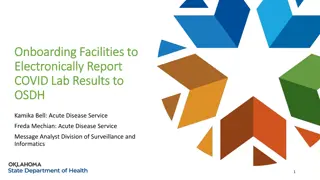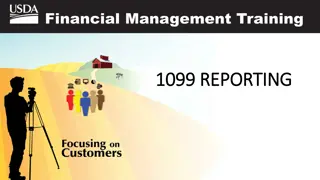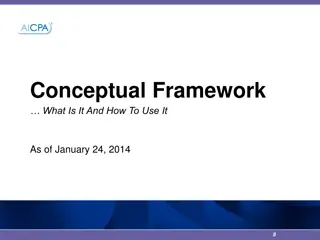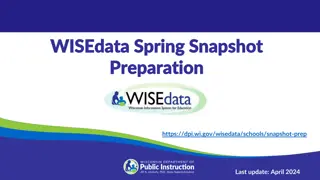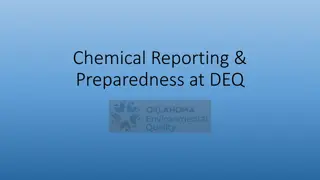Understanding the Conceptual Framework of Financial Reporting
The Conceptual Framework of Financial Reporting for 2019 outlines key chapters focusing on objectives, qualitative characteristics, financial statements, elements, recognition, measurement, presentation, and capital maintenance. It emphasizes the importance of providing information on stewardship and resource allocation to aid decision-making processes and achieve strategic goals. The framework serves to meet the diverse needs of users for making economic decisions and evaluating an entity's financial performance.
Download Presentation

Please find below an Image/Link to download the presentation.
The content on the website is provided AS IS for your information and personal use only. It may not be sold, licensed, or shared on other websites without obtaining consent from the author. Download presentation by click this link. If you encounter any issues during the download, it is possible that the publisher has removed the file from their server.
E N D
Presentation Transcript
[[insert heading]] Conceptual Framework - 2019 1
Conceptual Framework - Introduction Revised Chapters: Chapter 1: The objectives of financial reporting Chapter 2: Qualitative characteristics of useful financial information Chapter 3: Financial statements and the reporting entity Chapter: 4 The elements of financial statements Chapter 5: Recognition and de-recognition Chapter 6: Measurement Chapter 7: Presentation and disclosure 2 Chapter 8: Concept of capital and capital maintenance Conceptual Framework - 2019
Framework - Rationale The Conceptual Framework is not a standard, and none of the concepts override the concepts in any standards. General purpose financial statements are prepared to meet the common needs of most users for making economic decisions: Buy, hold or sell equity instruments Assess stewardship or accountability of management Assess the ability of the entity to pay and provide other benefits to employees Assess the security for amounts lent to the entity Determine taxation policies Determine distributable profits and dividends Prepare and used for national income statistics Regulate the activities of entities 3 Conceptual Framework - 2019
Objectives of Financial Statements The objective of financial statements is to present information about the entity and its activities (results) which are useful to users to make economic conditions focused on the treasury and reporting functions. The revised Framework includes the need to provide information on the principle of stewardship in order to enable users to assess allocation of resources and effective decision- making processes (governance) to achieve the strategic goals of the business Efficiency and effectiveness with which management discharged their responsibilities over the economic resources of the entity 4 Conceptual Framework - 2019
Objectives of Financial Statements The objective of financial statements is to provide financial information about the reporting entity s assets, liabilities, equity, income and expenses that is useful to users of financial statements in assessing the prospects for future net cash inflows to the reporting entity and in assessing management s stewardship of the entity s economic resources. Treasury function: management of the financial resources of the organization to ensure the solvency and liquidity of the business; and reporting to the stakeholders Stewardship function: management is accountable for the utilization of the resources of the organization to achieve the business objective in maximizing shareholders wealth 5 Conceptual Framework - 2019
Qualitative Characteristics Fundamental qualitative characteristics: Relevance capable of influencing or making a difference to the decisions of users (confirmatory and predictive values) Faithful representation faithfully represent the substance of what is purports to represent (complete, neutral and free from errors) Clarity was provided on what makes financial statements useful: Information must be relevant and faithfully represent the substance of the financial information 6 Conceptual Framework - 2019
Qualitative Characteristics Re-introduced the concept of Prudence to reduce confusion supports neutrality of information and described it as the exercise of caution when judgements under conditions of uncertainty Introduced the concept of Measurement uncertainty as a factor that can significant affect faithful representation level of uncertainty directly affects the relevance of the information Re-instatement of the principle of substance over form as a phenomenon that affects faithful representation 7 Conceptual Framework - 2019
Definition of Assets Previous definition: A resource controlled by the entity as a result of past events and from which future economic benefits are expected to flow to the entity Revised definition: A present economic resource controlled by the entity as a result of past events. An economic resource is a right that has the potential to produce economic benefits. The major change focuses on: The resource it changes to economic resources which include a set of rights The realization of the future economic benefit there is no longer the need for certainty or the likely of the benefits flowing to the entity 8 Conceptual Framework - 2019
Definition of Assets Effect of the change: Previous Operating Leases were recognized as expenses, but the change resulted them being recognized as assets capitalization of the rights in the economic resource (Only for Full IFRS) Similar, the same may apply to contracts which entitles the entity to have certain rights in economic resources 9 Conceptual Framework - 2019
Definition of Liabilities Previous definition: A present obligation of the entity arising from past events, the settlement of which is expected to result in an outflow from the entity of resources embodying economic benefits Revised definition: A present obligation of the entity to transfer an economic resource as a result of past events. An obligation is a duty of responsibility that the entity has no practical ability to avoid. 10 Conceptual Framework - 2019
Definition of Liabilities The major change focuses on: The economic benefits - changes from the outflow to the transfer of economic benefits (no needs for the expected outflow of benefits) Inclusion of clarity on obligation represents the responsibility of the entity to avoid fulfilling its obligations (onerous contracts) The factors used to assess no practical ability to avoid depends on the nature of the entity s duties and responsibilities requires professional judgement 11 Conceptual Framework - 2019
Recognition & De-recognition Transactions can only be recognized in the accounting records if they meet the definition of an element, and when their recognition provides users of financial statements with information about the items that is both relevant and faithfully represented (ie meets the qualitative characteristics of useful information). Derecognition aims to faithfully represent both: any assets and liabilities retained after the transaction or other event that led to the derecognition (including any asset or liability acquired, incurred or created as part of the transaction or other event) the change in the entity s assets and liabilities as a result of that transaction or other event. 12 Conceptual Framework - 2019
JOIN THE CONVERSATION AND BE #SAIPAproud @SAIPAcomms South African Institute of Professional Accountants SAIPA-South African Institute of Professional Accountants Conceptual Framework - 2019 13








